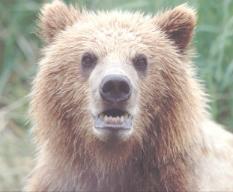
Surprisingly, this bear scat is bright 'hunter orange'. The question is "How did it get to be that color?". Deer season has just ended and there were a lot of hunters cruising the woods. Is there a hunter missing in action?
Closer inspection indicates that this scat is loaded with rose hips. Apparently this bear wanted a full dose of vitamin C before going into the winter den. It has already snowed in the mountains of eastern Washington and has been in the lower 20's at night. We can expect the bears to be settling into their dens any day now.
With luck this bear has put on a lot of weight and will enjoy the winter nap. Bears in other parts of the west have not been so lucky this year. Late freezes, drought and tree infestations in the Rocky Mountain West have diminished the sources of natural food from bugs to berries that the bears eat. Recently they have been hunting for food in all the wrong places, from backcountry campgrounds to suburban kitchens.
In Colorado, bears have burst through the front doors of homes, sauntered into stores and broken into cars. Officials say the number of bears killed by state wildlife officers this year has topped a new record.
Wildlife officers in northwest Wyoming, where luxury housing is crowding into prime bear habitat, are fielding 100 calls a week about bears feasting in fruit trees and snoozing on front lawns. Game wardens have killed twice as many bears this season as they kill in an average year.
In Montana, hungry bears have plowed through dumpsters and grabbed garbage from garages, a pattern Montana Fish, Wildlife and Parks Captain Sam Sheppard says is unusual for its scope, duration and intensity.
In Jackson Hole, Wyoming, where a bear recently lumbered through the open door of a daycare center, officials have plastered neighborhoods with signs urging residents to harvest fruit, remove birdfeeders and "bear-proof" their garbage.
Wildlife officers across Western states have renewed campaigns to stem bear conflicts by retraining humans. Its very important that food and garbage not be left outside in such a way that will attract bears. Keep in mind that next spring, when the bears wake up and sally forth, they will have lost 30% to 40% of their body weight and will be looking for food once again. If you live in bear country please bear proof your home.
We bears thank you.
extracts from a story by Laura Zuckerman, REUTERS NEWS SERVICE
photo credit Dennis Ryan


